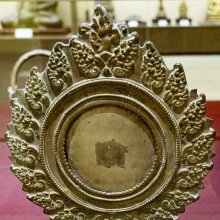Darpaṇa, Darpana, Darpaṇā: 29 definitions
Introduction:
Darpaṇa means something in Buddhism, Pali, Hinduism, Sanskrit, Jainism, Prakrit, Marathi, Hindi. If you want to know the exact meaning, history, etymology or English translation of this term then check out the descriptions on this page. Add your comment or reference to a book if you want to contribute to this summary article.
Alternative spellings of this word include Darpan.
Images (photo gallery)
In Hinduism
Shilpashastra (iconography)
Source: Google Books: Elements of Hindu iconographyDarpaṇa (दर्पण) means a mirror. In ancient times, when glass was either unknown or was not employed for making mirrors, highly polished metal plates of various designs were utilised to serve as mirrors. It may be remarked by the way that this old speculum industry has not yet died out in India. In a place called Āramuḷa in Travancore, such mirrors are still manufactured; and the mirrors made by the workmen of this place are so true that they do not show distortion in reflection. Glass mirrors are not allowed to be used in temple service in Malabar, and it is not rare to find in wealthy temples in this part of the country speculum mirrors even as large as three feet by two feet. In sculptures the darpaṇa is either circular or oval in form, and is mounted on a well-wrought handle.
Source: Shodhganga: The significance of the mūla-beras (śilpa)Darpaṇa (दर्पण, “mirror”) refers to one of the several “attributes” (āyudha) or “accessories” of a detiy commonly seen depicted in Hindu iconography, defined according to texts dealing with śilpa (arts and crafs), known as śilpaśāstras.—The śilpa texts have classified the various accessories under the broad heading of āyudha or karuvi (implement), including even flowers, animals, and musical instruments. Certain utensils and other objects that are commonly found in the hands of the images are, for example Darpaṇa.
Darpaṇa means a mirror. In ancient times, highly polished metal plates of various designs were utilized to serve as mirrors. The darpaṇa is either circular or oval in form, and is mounted on a well-wrought handle.

Shilpashastra (शिल्पशास्त्र, śilpaśāstra) represents the ancient Indian science (shastra) of creative arts (shilpa) such as sculpture, iconography and painting. Closely related to Vastushastra (architecture), they often share the same literature.
Purana and Itihasa (epic history)
Source: archive.org: Shiva Purana - English TranslationDarpaṇa (दर्पण) refers to a “mirror”, according to the Śivapurāṇa 2.2.21. Accordingly as Brahmā narrated to Nārada:—“[...] When they [viz., Śiva’s Gaṇas (attendants)] went away and He was left alone with Satī, Śiva rejoiced much and sported with her. [...] While Satī was admiring at the reflection of her face in the mirror (darpaṇa), Śiva came behind and peeped into the reflection of His own face”.
Source: Cologne Digital Sanskrit Dictionaries: The Purana IndexDarpaṇa (दर्पण).—A looking-glass to be installed by the side of a deity.*
- * Matsya-purāṇa 57. 18; 265. 19; 289. 10.

The Purana (पुराण, purāṇas) refers to Sanskrit literature preserving ancient India’s vast cultural history, including historical legends, religious ceremonies, various arts and sciences. The eighteen mahapuranas total over 400,000 shlokas (metrical couplets) and date to at least several centuries BCE.
Vyakarana (Sanskrit grammar)
Source: Wikisource: A dictionary of Sanskrit grammarDarpaṇa (दर्पण).—Name of a commentary on Kondabhatta's Vaiyakaranabhusanasara, written by a grammarian named Harivallabha.
--- OR ---
Darpaṇā (दर्पणा).—Name of a commentary on the Sabdakaustubha, written by Mannudeva or Mantudeva of the nineteenth century.

Vyakarana (व्याकरण, vyākaraṇa) refers to Sanskrit grammar and represents one of the six additional sciences (vedanga) to be studied along with the Vedas. Vyakarana concerns itself with the rules of Sanskrit grammar and linguistic analysis in order to establish the correct context of words and sentences.
Shaivism (Shaiva philosophy)
Source: Shodhganga: Temple management in the ĀgamasDarpaṇa (दर्पण) refers to one of the eight aṣṭamaṅgala and represents a type of “temple implement (instrument)” as described in the Karaṇalakṣaṇavidhi-paṭala section of the Uttara-Kāmikāgama.—The instruments should be according to the particular śāstra followed at the temple. Some of the instruments mentioned are Śaiva aṣṭamaṅgala including [viz., darpaṇa].
Source: Brill: Śaivism and the Tantric Traditions (philosophy)Darpaṇa (दर्पण) refers to a “mirror”, according to the Īśvarapratyabhijñāvivṛtivimarśinī 2.131:—“‘adhikatara’ [means the following]: the [various] phenomena are [something more (adhika)] than consciousness, just as reflections (ābhāsa) are something more than a mirror (darpaṇa) [reflecting them]; and that which is something more than something more, [i.e., that which is something more] than these very [phenomena,] can never be perceived in any [circumstance] for the very [reason that it is distinct from phenomena]; and how could that be a [real] entity (vastu)?”.

Shaiva (शैव, śaiva) or Shaivism (śaivism) represents a tradition of Hinduism worshiping Shiva as the supreme being. Closely related to Shaktism, Shaiva literature includes a range of scriptures, including Tantras, while the root of this tradition may be traced back to the ancient Vedas.
Jyotisha (astronomy and astrology)
Source: Wisdom Library: Brihat Samhita by VarahamihiraDarpaṇa (दर्पण) refers to a “mirror”, according to the Bṛhatsaṃhitā (chapter 4), an encyclopedic Sanskrit work written by Varāhamihira mainly focusing on the science of ancient Indian astronomy astronomy (Jyotiṣa).—Accordingly, “The moon (candra) is always below (nearer to the Earth than) the sun. It is spherical in shape. One half of it is always illumined by the light of the sun, while the other half is dark owing to its own shadow, just like a pot placed in the sun. The rays of the sun falling on the watery moon remove the darkness of the night (on Earth) just in the same way as light reflected from a mirror [i.e., darpaṇa] (placed in the sun) removes the darkness (from) within a room”.

Jyotisha (ज्योतिष, jyotiṣa or jyotish) refers to ‘astronomy’ or “Vedic astrology” and represents the fifth of the six Vedangas (additional sciences to be studied along with the Vedas). Jyotisha concerns itself with the study and prediction of the movements of celestial bodies, in order to calculate the auspicious time for rituals and ceremonies.
Shaktism (Shakta philosophy)
Source: Google Books: ManthanabhairavatantramDarpaṇa (दर्पण) refers to a “mirror”, according to the Manthānabhairavatantra, a vast sprawling work that belongs to a corpus of Tantric texts concerned with the worship of the goddess Kubjikā.—Accordingly, “ (Pūrṇacandrā), the goddess who resides in the door in the north is Pūrṇā Maṅgalā. She has five faces and ten arms and sits on a lion. She wears the full moon on her head. The left hands make gestures of fearlessness and boon bestowal, and hold a mirror [i.e., darpaṇa], a noose, and goad. In the right hands she holds a dagger, bow, sword, pestle, and a fearsome spear. She bestows boons in the north”.

Shakta (शाक्त, śākta) or Shaktism (śāktism) represents a tradition of Hinduism where the Goddess (Devi) is revered and worshipped. Shakta literature includes a range of scriptures, including various Agamas and Tantras, although its roots may be traced back to the Vedas.
Kavya (poetry)
Source: Brill: Śaivism and the Tantric Traditions (kavya)Darpaṇa (दर्पण) refers to “mirrors”, according to Bāṇa’s Kādambarī (p. 224-228).—Accordingly, “[Going ahead a little, he then sees that the Goddess Caṇḍikā] was enclosed by a door made from the ivory of wild elephants, as yellowish-white as fragments of ketakī filaments, and an iron architrave bearing an ornamental garland of black iron mirrors (kālāyasa-darpaṇa) surrounded by a row of red yak tail whisks resembling a garland of Śabara heads horrific with tawny hair”.

Kavya (काव्य, kavya) refers to Sanskrit poetry, a popular ancient Indian tradition of literature. There have been many Sanskrit poets over the ages, hailing from ancient India and beyond. This topic includes mahakavya, or ‘epic poetry’ and natya, or ‘dramatic poetry’.
In Buddhism
Tibetan Buddhism (Vajrayana or tantric Buddhism)
Source: academia.edu: The Structure and Meanings of the Heruka MaṇḍalaDarpaṇa (दर्पण) refers to a “mirror” and represents one of the items held in the right hand of Heruka: one of the main deities of the Herukamaṇḍala described in the 10th century Ḍākārṇava chapter 15. Heruka is positioned in the Lotus (padma) at the center; He is the origin of all heroes; He has 17 faces (with three eyes on each) and 76 arms [holding, for example, darpaṇa]; He is half black and half green in color; He is dancing on a flaming sun placed on Bhairava and Kālarātrī.
Source: MDPI Books: The Ocean of HeroesDarpaṇa (दर्पण) refers to a “mirror”, according to chapter 50 of the 10th-century Ḍākārṇava-tantra: one of the last Tibetan Tantric scriptures belonging to the Buddhist Saṃvara tradition consisting of 51 chapters.—Accordingly, “Now, I will explain the characteristic of Mahākaṅkāla. [...] [The currents] rest in the middle of the skull by means of the mirror-like consciousness (darpaṇa-ākāra-cetas). Assuming the appearance of streams of immortal nectar [poured out] from a pot, they flow in the middle of a hollow [viz, channel in his head]. He should meditate that [this awakening] mind undergoes states such as absorption and enjoyment. [If he performs] the yoga of a donkey in that hollow, he sees the seven-time born. The appearances of mother-borns are three; likewise, the father-borns are three. [...]”.

Tibetan Buddhism includes schools such as Nyingma, Kadampa, Kagyu and Gelug. Their primary canon of literature is divided in two broad categories: The Kangyur, which consists of Buddha’s words, and the Tengyur, which includes commentaries from various sources. Esotericism and tantra techniques (vajrayāna) are collected indepently.
In Jainism
General definition (in Jainism)
Source: archive.org: TrisastisalakapurusacaritraDarpaṇa (दर्पण) refers to the “mirror” and represents one of the “eight auspicious thins” in Jainism, according to chapter 1.2 [ādīśvara-caritra] of Hemacandra’s 11th century Triṣaṣṭiśalākāpuruṣacaritra: an ancient Sanskrit epic poem narrating the history and legends of sixty-three illustrious persons in Jainism.
Accordingly:
Source: Shodhganga: A cultural study on the jain western Indian illustrated manuscripts“[...] Then, after circumambulating it, he ascended his aerial car, like his own lofty pride, by the east steps. [...] Then Śakra’s Śāmānikas, like other forms of Śakra, ascended by the north steps and took their proper seats. [...] In front of the Lord of Paulomī (Śakra) seated on the lion-throne shone eight groups of the eight auspicious things, [viz., darpaṇa], etc. [...]”.
Darpaṇa (दर्पण, “mirror”).—One of the eight providential symbols, or, aṣṭamaṅgala.—One is able to see one’s own self in it. A human being in order to be able to realize knowledge of oneself goes through austerities of ascetic meditation, charitable acts and observance of celibacy, which are a man’s embellishments.

Jainism is an Indian religion of Dharma whose doctrine revolves around harmlessness (ahimsa) towards every living being. The two major branches (Digambara and Svetambara) of Jainism stimulate self-control (or, shramana, ‘self-reliance’) and spiritual development through a path of peace for the soul to progess to the ultimate goal.
Languages of India and abroad
Marathi-English dictionary
Source: DDSA: The Molesworth Marathi and English Dictionarydarpaṇa (दर्पण).—n (S & m) A mirror. Pr. andhaḷyāsa da0 kāya.
Source: DDSA: The Aryabhusan school dictionary, Marathi-Englishdarpaṇa (दर्पण).—n A mirror.
Marathi is an Indo-European language having over 70 million native speakers people in (predominantly) Maharashtra India. Marathi, like many other Indo-Aryan languages, evolved from early forms of Prakrit, which itself is a subset of Sanskrit, one of the most ancient languages of the world.
Sanskrit dictionary
Source: DDSA: The practical Sanskrit-English dictionaryDarpaṇa (दर्पण).—&c. See under दृप् (dṛp).
See also (synonyms): darpa, darpita.
--- OR ---
Darpaṇa (दर्पण).—[dṛp-lyu]
1) A looking-glass, mirror; लोचनाभ्यां विहीनस्य दर्पणः किं करिष्यति (locanābhyāṃ vihīnasya darpaṇaḥ kiṃ kariṣyati) Chāṇ.19; Kumārasambhava 7.26; R.1. 1;14.37.
2) Name of a mountain inhabited by Kubera.
-ṇam 1 The eye.
2) Kindling, inflaming, making proud.
Derivable forms: darpaṇaḥ (दर्पणः).
Source: Cologne Digital Sanskrit Dictionaries: Shabda-Sagara Sanskrit-English DictionaryDarpaṇa (दर्पण).—m.
(-ṇaḥ) A mirror. n.
(-ṇaṃ) 1. The eye. 2. Kindling, inflaming. E. dṛp to excite, to shine, affix lyu .
Source: Cologne Digital Sanskrit Dictionaries: Benfey Sanskrit-English DictionaryDarpaṇa (दर्पण).—i. e. dṛp + ana, m. A mirror, [Meghadūta, (ed. Gildemeister.)] 59.
Source: Cologne Digital Sanskrit Dictionaries: Cappeller Sanskrit-English DictionaryDarpaṇa (दर्पण).—[masculine] looking-glass, mirror; often —° in titles of books.
Source: Cologne Digital Sanskrit Dictionaries: Aufrecht Catalogus Catalogorum1) Darpaṇa (दर्पण) as mentioned in Aufrecht’s Catalogus Catalogorum:—in dharma. See Dānadarpaṇa, Pratiṣṭhādarpaṇa, Pravaradarpaṇa, Māsadarpaṇa.
2) Darpaṇa (दर्पण):—[dharma] B. 3, 90. Oppert. 273. 2512. Quoted by Raghunandana Oxf. 292^a.
—by Śrīnivāsācārya. Rice. 200.
3) Darpaṇa (दर्पण):—prayoga, by Vīrarāghavācārya. Oppert. Ii, 935. 2784.
4) Darpaṇa (दर्पण):—a
—[commentary] on Bṛhadvaiyākaraṇabhūṣaṇa and Laghuvaiyākaraṇabhūṣaṇa, by Harivallabha.
5) Darpaṇa (दर्पण):—an abbreviation of Sāhityadarpaṇa.
Source: Cologne Digital Sanskrit Dictionaries: Monier-Williams Sanskrit-English Dictionary1) Darpaṇa (दर्पण):—[from darpa] a m. ([gana] nandy-ādi) ‘causing vanity’, a mirror, [Harivaṃśa 8317; Rāmāyaṇa ii; Śakuntalā] etc.
2) [v.s. ...] ifc. ‘Mirror’ (in names of works) e.g. ātaṅka-, dāna-, sāhitya-
3) [v.s. ...] = dāna-, [Smṛtitattva iv]
4) [v.s. ...] Name of a measure (in music)
5) [v.s. ...] of a mountain (seat of Kubera), [Kālikā-purāṇa]
6) [v.s. ...] of Śiva, [Mahābhārata xiii, 1194]
7) [v.s. ...] n. the eye, [cf. Lexicographers, esp. such as amarasiṃha, halāyudha, hemacandra, etc.]
8) [v.s. ...] repetition, [Varāha-mihira’s Bṛhat-saṃhitā iii, 11 [Scholiast or Commentator]]
9) [v.s. ...] kindling, [Horace H. Wilson]
10) [v.s. ...] b [Nominal verb] [Parasmaipada] ṇati to represent a mirror.
Source: Cologne Digital Sanskrit Dictionaries: Yates Sanskrit-English DictionaryDarpaṇa (दर्पण):—(ṇaḥ) 1. m. A mirror. n. The eye; a kindling.
Source: DDSA: Paia-sadda-mahannavo; a comprehensive Prakrit Hindi dictionary (S)Darpaṇa (दर्पण) in the Sanskrit language is related to the Prakrit word: Dappaṇa.
[Sanskrit to German]
Sanskrit, also spelled संस्कृतम् (saṃskṛtam), is an ancient language of India commonly seen as the grandmother of the Indo-European language family (even English!). Closely allied with Prakrit and Pali, Sanskrit is more exhaustive in both grammar and terms and has the most extensive collection of literature in the world, greatly surpassing its sister-languages Greek and Latin.
Hindi dictionary
Source: DDSA: A practical Hindi-English dictionaryDarpaṇa (दर्पण) [Also spelled darpan]:—(nm) a looking glass, mirror.
...
Kannada-English dictionary
Source: Alar: Kannada-English corpusDarpaṇa (ದರ್ಪಣ):—[noun] a glass with a silvery, metallic or amalgam backing that reflects the images of objects; a looking glass; a mirror.
Kannada is a Dravidian language (as opposed to the Indo-European language family) mainly spoken in the southwestern region of India.
Nepali dictionary
Source: unoes: Nepali-English DictionaryDarpaṇa (दर्पण):—n. looking-glass; mirror;
Nepali is the primary language of the Nepalese people counting almost 20 million native speakers. The country of Nepal is situated in the Himalaya mountain range to the north of India.
See also (Relevant definitions)
Full-text (+1854): Yogadarpanatika, Jnanadarpana, Karnadarpana, Shitacampaka, Manidarpana, Ratnadarpana, Harivallabha, Darpanakara, Darpanamaya, Pravaradarpana, Rupana, Paratantrata, Hahaha, Anaucitya, Chaddalika, Anugunya, Kundalita, Muhurtadarpana, Uparupaka, Anusvana.
Relevant text
Search found 46 books and stories containing Darpaṇa, Darpana, Darpaṇā; (plurals include: Darpaṇas, Darpanas, Darpaṇās). You can also click to the full overview containing English textual excerpts. Below are direct links for the most relevant articles:
Blue Annals (deb-ther sngon-po) (by George N. Roerich)
Chapter 9 - Darpaṇa Ācārya < [Book 14 - Great Compassion Cycle]
Śrī Kṛṣṇa-vijaya (by Śrī Gunaraja Khan)
The Aesthetics of Indian Dance < [January – March, 1985]
Theories of the Drama: Aristotle vs. the Indian Theorists < [July-August 1931]
In Reminiscent Mood < [January-February, 1929]
Mudrarakshasa (literary study) (by Antara Chakravarty)
2.5. Use of Vaṃśasthavila metre < [Chapter 4 - Employment of Chandas in Mudrārākṣasa]
The Tattvasangraha [with commentary] (by Ganganatha Jha)
Verse 244-245 < [Chapter 7 - Doctrine of the Self (ātman, ‘soul’)]
Verse 2219-2220 < [Chapter 24a - The case for the reliability of the Veda (the Revealed Word)]
A History of Indian Philosophy Volume 3 (by Surendranath Dasgupta)
Part 21 - Śaila Śrīnivāsa < [Chapter XX - Philosophy of the Rāmānuja School of Thought]
Part 4 - Rāmānuja Literature < [Chapter XVIII - An Historical and Literary Survey of the Viśiṣṭādvaita School of Thought]
Related products



